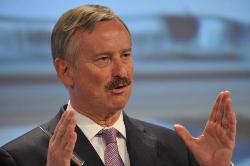European transport commissioner Siim Kallas unveiled Europe's long-awaited long-term transport policy in March, which will inform the EC's approach to aviation in the years ahead. And the industry took some heart from the policy statements recognising the key role of mobility.
The EC's Transport 2050 White Paper aims to create a single European Transport Area with a fully integrated network, linking the different modes of transport and providing for a more competitive environment. The wide-ranging plan tackles all forms of transport and aims to dramatically cut Europe's dependence on imported oil and to reduce carbon emissions by 60% by 2050.
But Kallas contends that mobility does not need to be cut to fight climate change. "Curbing mobility is not an option," he says. "Neither is business as usual. We can break the transport system's dependence on oil without sacrificing its efficiency and compromising mobility. It can be win-win."
 |
|---|
Kallas: curbing mobility is not an option |
Airports grouping ACI Europe was also supportive of the White Paper. It "unequivocally reconciles the growth of transport with the EU's ambitious environmental agenda, and is the political signal everyone in the aviation industry has been waiting for".
But while supporting the target of 40% use of low-carbon fuel in aviation by 2050, and plans to connect all core network airports to the, preferably high-speed, rail network, ACI cautions against unrealistic expectations.
CAPACITY CONCERNS
It says airport capacity remains a real concern. "Improved intermodality will provide better mobility," says Olivier Jankovec, ACI Europe director general, "but it will not solve the airport capacity crunch. Independent forecasts clearly indicate that demand for aviation in Europe will nearly double by 2030. The extensive rail developments announced will only absorb 0.5% of the total demand for air transport.
"Given the ever-increasing difficulties and uncertainties that Europe's airports face in seeking expansion approvals, the blunt reality of unprecedented congestion will sneak up on us very quickly. Europe's airports need their licence to grow."
According to ACI Europe, the recently announced revision of the EU regulation on airport slots will not be able to address congestion, being merely about managing scarce capacity.
A joint position paper issued by eight airline associations, including IATA, AEA, ELFAA, IACA and ERA, emphasises that they do not "see any need for a revision or any justification for it". The problem lies not in the allocation of slots, but in the lack of capacity at congested airports. They argue the need to introduce any form of slot restriction at an airport is an indication of failure on the part of government or airport authorities to invest in essential aviation infrastructure.
Jankovec says that the lack of airport capacity will not only be an obstacle to efficient mobility, but will also directly threaten the EU's flagship aviation programme, the Single European Sky.
The European Commission's own figures are illuminating. Congestion, it says, is already costing Europe about 1% of GDP each year. Furthermore, with nine million flights across EU airspace, representing an average of 25,000 flights each day, and 27 different air transport management systems across the EU, some 49km (26nm) are added to each air journey. This adds up to 1.225 million km (675,000nm) every day.
The problem is acute and will only get worse. The AEA warns the tortuous process towards the Single Sky has already taken far too long to come to fruition. "The Single Sky," says AEA secretary general Ulrich Schulte-Strathaus, "will benefit the environment, to the tune of many millions of tonnes of CO2 annually, needlessly produced flying circuitous routeings. And it will address a huge chunk of inefficiency which burdens the European airlines' cost base and hampers their global competitiveness." The Single European Sky should deliver a 10% reduction in air journeys, with a significant reduction in fuel used and emissions.
There have been no dissenting voices to the aim of extending the European Common Aviation Area, to create the largest integrated aviation market in the world, bringing together 58 countries and serving one billion consumers. It envisages extending liberalisation with partners from south-eastern and northern Europe to develop the common aviation area.
There are large cost implications in the Transport 2050 plan. The cost of EU infrastructure development to match demand for transport as a whole has been estimated by the EC at €1.5 trillion ($2.17 trillion) over the next 20 years. Another €1 trillion may be required for vehicles and equipment, to achieve the emission reduction goals.
Finance from public and private sources will be required, but the EC accepts that an improved regulatory framework and innovative financial instruments will be needed to unlock the potential of private finance.
Read more on the future capacity challenges ahead in Europe
Source: Airline Business























